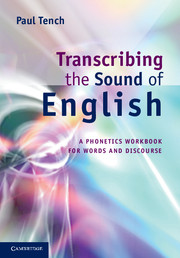9 - Intonation
tonicity
from Part II - . . . and Discourse
Published online by Cambridge University Press: 05 June 2012
Summary
Tonicity is the location of the most prominent syllable in an intonation unit. Tonality represents the speaker’s division of the total message into separate pieces of information; tonicity, on the other hand, identifies the focus of each piece of information. This function can easily be demonstrated by listening to one sentence spoken with different tonicity:
The first rendering focuses on Monday, whereas the second focuses on them coming. The second one can only make sense if some mention of the people’s movements on Monday has already been mentioned or is already known, and now some contrast or correction is intended, e.g. they are not leaving on Monday! Tonicity tells you what the focus of the information is, whereas tonality tells you what the pieces of information are.Each piece of information – each intonation unit – will have one focus, one tonic syllable. Occasionally, a speaker will begin an intonation unit but decide to abandon it before starting their information afresh; in such cases, there might be no tonic syllable and so we call such interrupted units ‘abandoned’ units: the full information was not given and the choices of focus and tone were not made either. Some examples were noticed in Dangerous childhood pranks2. Normally, however, each intonation unit will contain one tonic syllable; and the presence of the tonic syllable is obligatory for the delivery of a complete intonation unit.What makes a syllable a tonic syllable? Usually, in each intonation unit there will be one syllable more prominent than the others; it is made more prominent by a degree of loudness greater than the other syllables, and it is accompanied by a distinctive pitch movement or level. There is sometimes a noticeable reduction in the pace of the syllables after the tonic syllable, compared to the quicker pace beforehand. All these clues help, but they may not always be present together. Try and identify the tonic syllables in these four sentences:
It should not be too difficult to identify them; they were the last words in the first three and the last one but two in the fourth sentence. Notice that they were all lexical items – content words, not grammatical items (‘structural’ words). In iv above, the last two words up there both belong to closed sets of locative adverbs and are thus treated as grammatical items. So, although man is not the last word, it is still the last lexical item. Note also that each sentence was a different clause type: a declarative, a wh-interrogative (i.e. non-polar), a yes/no interrogative (i.e. polar) and an imperative; the type of clause seems to have no bearing on either tonality or tonicity.
- Type
- Chapter
- Information
- Transcribing the Sound of EnglishA Phonetics Workbook for Words and Discourse, pp. 149 - 157Publisher: Cambridge University PressPrint publication year: 2011



